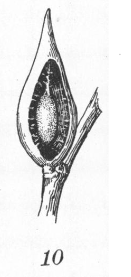Amphibolips quercuscoelebs (sexgen)
Cynips quercus coelebs n. sp.
Quercus rubra. Red Oak. Elongated, fusiform, pale green gall, with a pedicel, inserted on the edge of the leaf and being the prolongation of a leaf-vein. Length about an inch.
The pedicel is about 0.15-0.2 long; the gall itself is an elongated, subcylindrical body, tapering on both sides, 0.6 or 0.7 long; its apex is slender, about 0.1 or 0.15 long. I have found three specimens of this gall near Washington, in June; two are inserted on the margin of the leaf, not far from the stalk; the third is on the leaf-stalk itself, but so that on the side of the gall the leaf originates about half an inch above its place of insertion, whereas on the other side the beginning of the leaf corresponds exactly to the place of insertion of the gall-stalk. In all the three cases, the gall is the prolongation of a vein; in the latter case, the vein, in consequence of the growth of the leaf, has become entirely independent of the blade and appears to be growing out of the leaf-stalk.
The inside of these galls is hollow; each contains a brownish, oblong nucleus, kept in position by woody fibers. On the 17th of June I obtained the gall-fly from one of my specimens; on June 28th a parasite from the other; the third was dry when I found it. The gall-fly is a male.
”- Baron Osten Sacken: (1861) On the Cynipidae of the North American Oaks and their Galls©
Reference: https://www.biodiversitylibrary.org/item/22852#page/80/mode/1up





